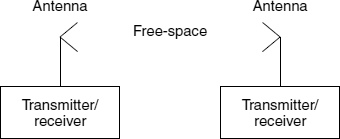CHAPTER TWELVE
Antennas
12.1 INTRODUCTION
An antenna is a component that radiates and receives RF or microwave signal. It is a reciprocal device, so the same antenna can serve as a receiving or transmitting device. Antennas are structures that provide transitions between guided and free-space waves. Guided waves are confined to the boundaries of a transmission line to transport signals from one point to another, while free-space waves radiate unbounded. A transmission line is designed to have very little radiation loss, while the antenna is designed to have maximum radiation. The radiation occurs because of discontinuities (which cause the perturbation of fields or currents), unbalanced currents, etc.
The antenna is a key component in any wireless system, as shown in Figure 12.1. The RF/microwave signal is transmitted to free space through the antenna. The signal propagates in space, and a small portion is picked up by a receiving antenna. The signal will then be amplified, downconverted, and processed to recover the information.
There are many types of antennas; Figure 12.2 gives some examples. They can be classified in different ways. Some examples are:
- Shapes or geometries
- Wire antennas: dipole, loop, helix;
- aperture antennas: horn, slot;
- Printed antennas: patch, printed dipole, spiral.
- Gain
- High gain: dish;
- Medium gain: horn;
- Low gain: dipole, loop, slot, patch.

FIGURE 12.1 ...
Get RF and Microwave Circuit and Component Design for Wireless Systems now with the O’Reilly learning platform.
O’Reilly members experience books, live events, courses curated by job role, and more from O’Reilly and nearly 200 top publishers.

